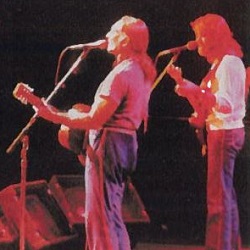From the April 1983 issue of the late, great Recording Engineer/Producer (RE/P) magazine, David Scheirman takes a look inside the Willie Nelson & Family tour of 1983.
It is perhaps safe to say that the Willie Nelson organization has been spending more production dollars for sound and lighting than most other country-oriented acts.
Nelson’s house mix engineer, Mike Garvey, of Dallas, Texas, explains hie part in the decision-making process when it came down to choosing a sound system for the tour:
“It’s not as if I have a blank check or anything, but I was given the authority to go with the best. We are using Innovative Audio to provide us with Gamble consoles and electronics and stage monitors; the main house speaker system is from Showco.
“I could not find everything I wanted from one company, so we ended up with two. It is an unfortunate situation to split it up like that, but I have a commitment to Willie to give him the best I can find, and that is how it has worked out.”
Showco House Speaker System
Garvey feels that Willie Nelson’s touring requirements are a bit unusual, when compared to “typical” concert tours — if such a thing exists.
“We aren’t like Van Halen or somebody like that, where you play the same kind of venue in every city you do,” he offers. “We play an extremely wide variety of places. We might be in a little-bitty club with 150 people one night, and be looking at 50,000 folks outdoors the next day. I needed a speaker system that could handle anything.”
“A lot of the available systems are either good for short-throw, wide dispersion situations, or else they are set up to be a long-throw system and end up being very ‘beamy.’ I need something very versatile. And, doing a show which is primarily vocals, I need to get those mids and highs all the way to the back of the hall really get that articulation out there. The Showco pyramid system is one I am really confident in, and have had a lot of experience with. ” (See: R-e/p December 1981 issue; “Showco Doing The Audio For The Rolling Stones Tour” Ed.)
Garvey, a former Showco employee, has a particular preference for the Showco method of stacking the mid-range horns inside the cabinets, and also is pleased with the low-frequency projection. “The pyramid box is actually a vented horn-loaded box… it has a 10-inch port. You get the best of both horn-loading and reflex action,” he claims.
Innovative Audio’s Front End
The choice of Innovative Audio came about largely due to the company’s reputation as a reliable supplier of consoles manufactured by Jim Gamble Associates.
Rapidly becoming the favorite of many experienced concert sound engineers, Gamble custom-built consoles are quite popular due to their many utilitarian features, and excellent sonic quality.
But why did Garvey go out of his way to hire a separate sound company just to gain access to a Gamble board? “There are a whole bunch of reasons!” he recalls. “It is really clean . . . it seems to be a real bright sounding board. To my ears, the console seems to have a different sound to it . . . a ‘faster,’ cleaner sound; it sounds better than any other console I have ever used. And, there is the built-in spectrum analyzer, onboard graphics, and so on (Figure 1).
“The graphic is the cleanest I have ever used . . . if I go even 3 dB up or down on a given frequency, I figure that something is wrong somewhere else. And the console is really reliable. In two years, I have only had a couple of failures . and one of them wasn’t the board’s fault; some guy threw a beer on the board!”
Innovative Audio’s David Morgan echoes Garvey’s comments about the Gamble console’s reliability: “This board you are looking at [Figure 2] has probably done about 1,500 shows. We have eight of these available to us, and very rarely have any down-time.”
Morgan says that the consoles were designed with easy field servicing in mind. “The modular panels are quickly and easily removed. And you can find many of the circuit board components at any Radio Shack. But don’t get me wrong, there’s some expensive stuff in there. The capacitors are Sprague-type solid tantalum; the resistors are Allen-Bradley 1% tolerance. It all adds up to a -130 dBv equivalent input noise signal ratio.”







